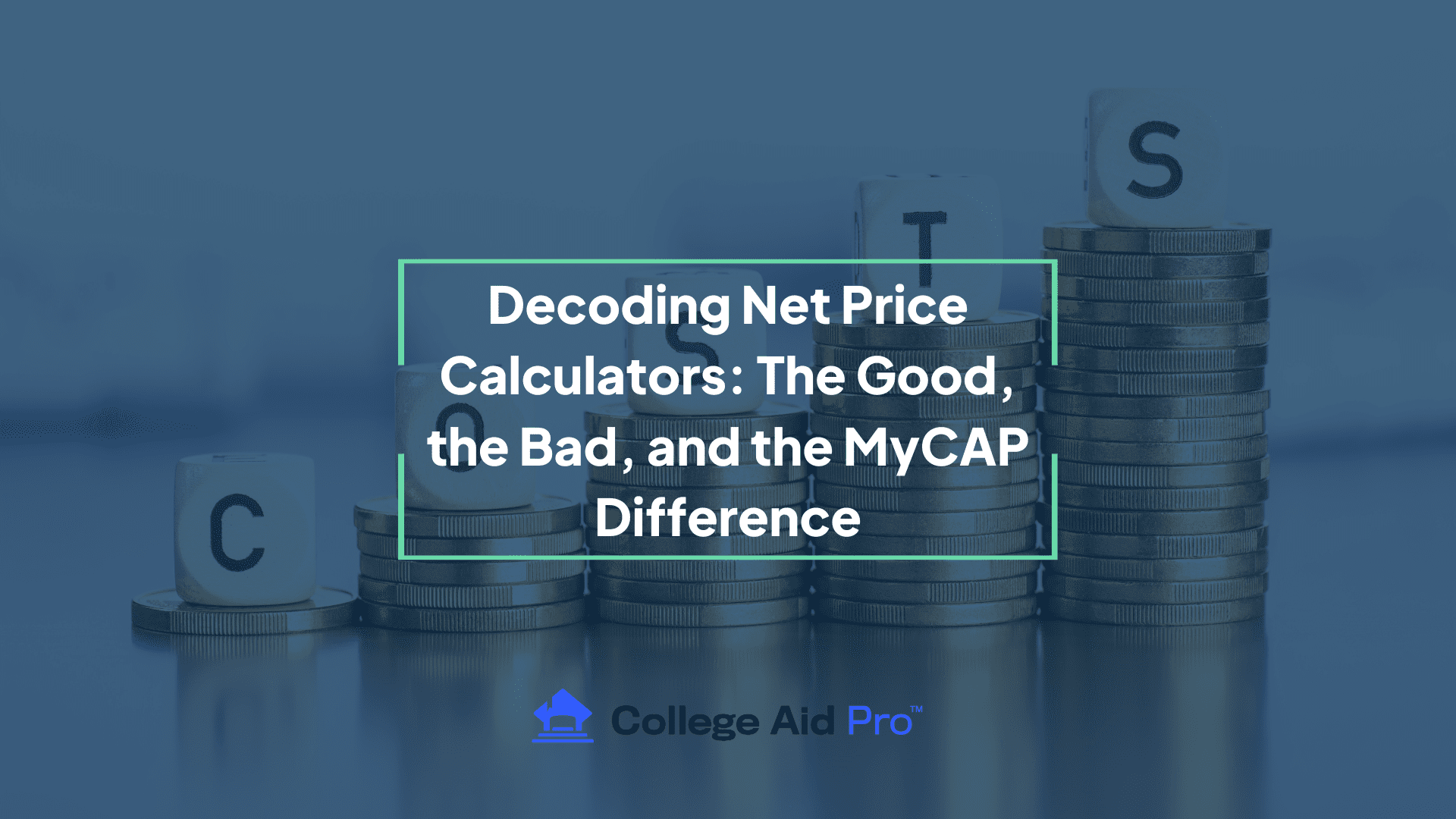Net Price Calculator’s vs. MyCAP SAI Estimates
You’ve heard the expression “less is more?” Well, sometimes less IS more and sometimes less is just less. When it comes to Net Price Calculators (NPCs), less is A LOT less.
What is a Net Price Calculator?
Every college or university in the United States has a net price calculator or NPC on its website…somewhere. The easiest way to find it is to type “NPC” into the site’s search bar. Otherwise, it’s often buried away.
The Net Price Calculator requirement has been in place for 68 years starting with The Higher Education Act of 1965. It specifically requires schools that participate in the Federal Student Aid program (Title IV Institutions) to provide a tool that helps students estimate their cost of attendance based on admissions data from the prior year and that student’s particular situation.
Schools have the option of using the template provided by the US Department of Education (DOE) or developing their own calculator. If a school doesn’t use the DOE’s template, the one they create must provide at least as much information as that of the department.
Problems with the Net Price Calculator requirement
Lack Of Oversight
The DOE states that they expect the NPC to be updated annually but that there is no approval process for schools that do not use the template provided by the department. It is up to each school to keep their NPC up to date and provide at least the minimum amount of information.
Insufficient Information
For the DOE’s tool, schools combine need and non-need merit aid and report the median awarded to students within the same SAI (Student Aid Index, formerly EFC) range. The SAI groupings cut off at 40,000 such that all SAI’s of 40,000 or higher are combined and given the same median award amount, all else being equal. So, If one student’s SAI is estimated to be 40,000 and another’s is estimated to be 100,000. They would both receive the same net cost estimate according to the DOE’s calculator.
Furthermore, a student with a 1600 SAT score would receive the same net cost estimate as one with a score of 1000, all other things being equal.
The questions asked by the DOE’s template to establish a student’s estimated SAI are few and leave out most of the details that go into calculating the SAI. Here is a screenshot of the information used to estimate a student’s SAI.
It doesn’t ask for any information about assets, for example, which could easily throw a family into a different SAI tier. Considering that the FAFSA has over 30 questions and pulls in tax information directly from the IRS, it’s easy to see why the DOE’s NPC template is inadequate.
If this is the minimum requirement, and there is no way to verify that a school even updates their NPC, no wonder so many of them give inaccurate estimates.
How MyCAP Is Different
MyCAP doesn’t use just one or two data points to place you within an SAI range. The MyCAP software takes into account information the colleges report about how they provide financial aid. It uses other available data resources and proprietary information based on actual award letters to make net cost projections.
It then compares a student’s academic profile to the merit awards available from each school to predict how much merit aid they might be given. We have every possible merit award in our database along with the school’s reported percentage of students receiving merit aid.
Essentially, MyCAP doesn’t try to simplify its net cost calculation, it gets specific. It projects what colleges actually award versus what they say they award or just matching an NPC. That specificity is what families need to understand their cost of college and how their situation will impact their cost at one institution versus another.
A Real World Example
Let’s look at a real example of a family that worked with College Aid Pro. The student in this case, we’ll call him Justin, was very interested in attending Northeastern University. Being concerned about cost, he ran his information through MyCAP and also the school’s own Net Price Calculator. This particular student had an SAI of $31,000.
Northeastern’s NPC predicted a cost of $20,245, while MyCAP gave an estimate of $48,381. Fortunately, because of the MyCAP estimate, Justin understood that he should apply to some other schools that might offer him more aid and not count on paying only $20,000 per year to attend Northeastern. He was thankful he did because his award package came in showing his net cost at $47,800, much higher than the Northeastern NPC had predicted but right on target with MyCAP’s estimate.
Now, I would be remiss if I didn’t point out that some schools are doing NPC the right way. In general, the more questions you have to answer for the NPC, the more accurate it is likely to be.
So, Should I Ignore All NPC’s?
There are times when it makes sense to run a school’s NPC. If you’re planning to apply Early Decision somewhere and you are counting on getting any type of financial aid, it makes sense to run the school’s NPC and compare it to MyCAP.
If there is a difference, you should seek guidance from a professional at MyCAP and your admissions advisor at that school. You don’t want to end up in a situation where you are counting on aid that doesn’t come through.
In general, it’s not a bad idea to run the NPC of each school you plan to apply to. More information is not a bad thing in high stakes financial situations.
Just know that if the calculator is depending on only a small amount of information to give you an estimate, the results are much less likely to be in the ballpark. This is definitely a case where it makes sense to plan for the worst and hope for the best. Be sure that at least some schools on your list are showing a net cost that is going to be affordable for your family.
I am a firm believer in using less when less is more, but when it comes to estimating your cost of college, there’s no denying it – more is more!



